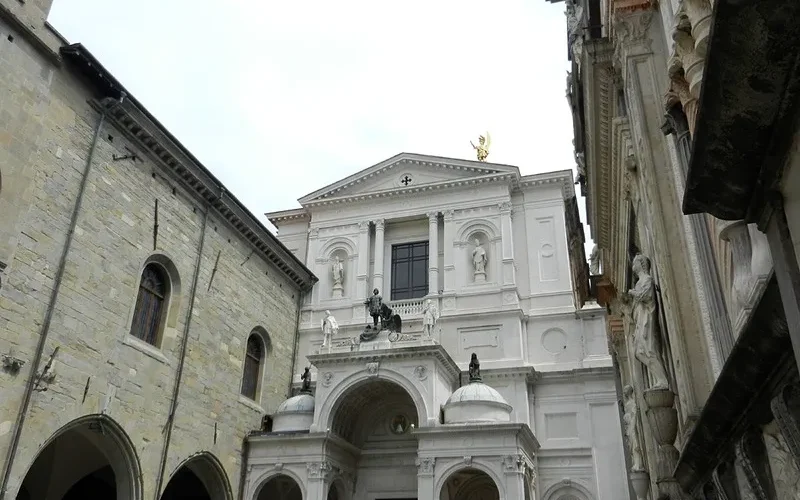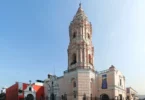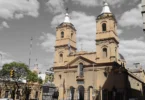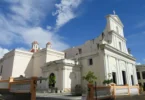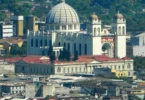Introduction
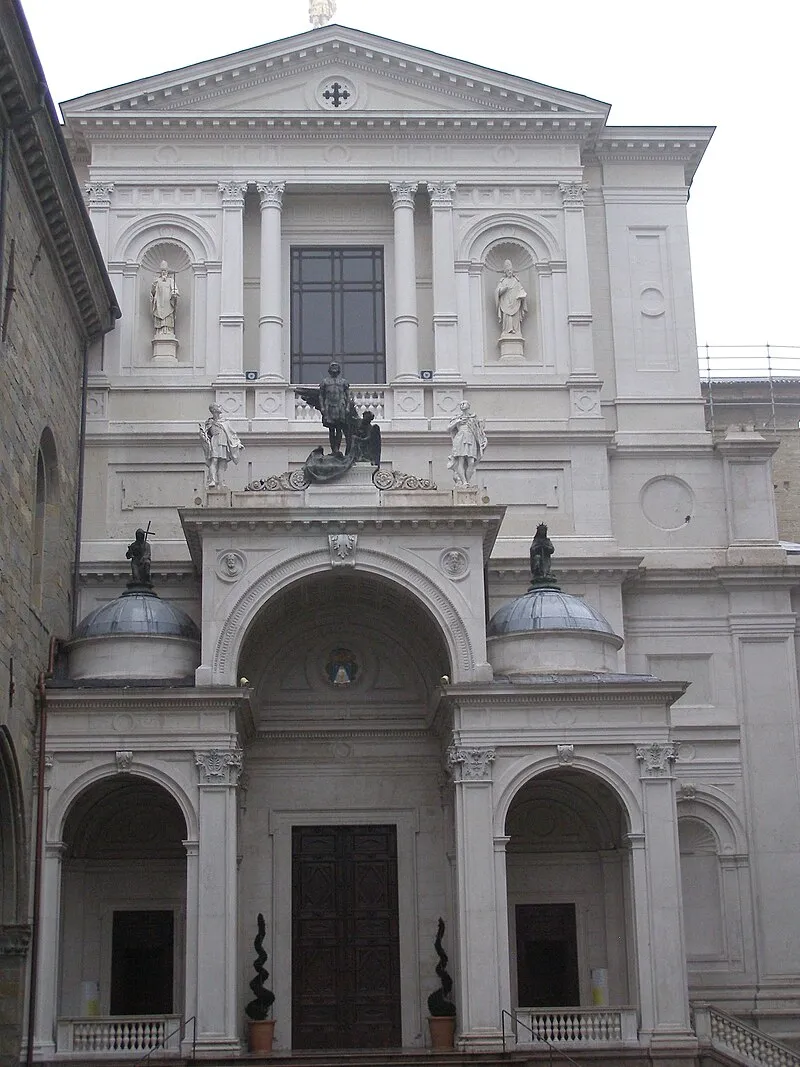
The Cathedral of Bergamo (Duomo di Bergamo, officially Cattedrale di Sant’Alessandro) is the foremost Roman Catholic church in the city of Bergamo, Lombardy, and serves as the episcopal seat of the Bishop of Bergamo. Dedicated to Saint Alexander of Bergamo, the city’s patron saint and martyr, the cathedral stands as a spiritual and historical cornerstone in the life of the city. Situated in the Upper City (Città Alta), the cathedral occupies a central position in the picturesque Piazza del Duomo, an area steeped in medieval and Renaissance heritage. It is flanked by two of Bergamo’s most iconic architectural monuments: the Palazzo della Ragione, once the seat of civic power, and the richly decorated Basilica of Santa Maria Maggiore, creating a unique and harmonious religious and civic ensemble.
The cathedral’s origins trace back to a much earlier dedication—not to Saint Alexander, but to Saint Vincent of Zaragoza, reflecting the initial wave of Christian devotion in the region. However, the cathedral’s identity underwent a significant transformation in the 16th century. In 1561, the original Basilica of Sant’Alessandro, which was built over the traditional site of the saint’s martyrdom and served as his burial place, was demolished by order of the Venetian Republic. This dramatic act was part of the strategic redesign of Bergamo’s defenses, as Venice commissioned the construction of a massive system of new city walls.
With the loss of the original site of veneration, the title and patronal dedication of Saint Alexander were transferred to the existing Cathedral of Saint Vincent. This shift not only preserved the cult of the saint but also elevated the cathedral’s liturgical and symbolic importance, uniting Bergamo’s spiritual legacy under one roof. Today, the Cattedrale di Sant’Alessandro stands not only as the mother church of the Diocese of Bergamo, but also as a profound symbol of continuity, faith, and the enduring memory of the city’s patron saint, whose presence still echoes through the art, architecture, and devotion that define this sacred space.
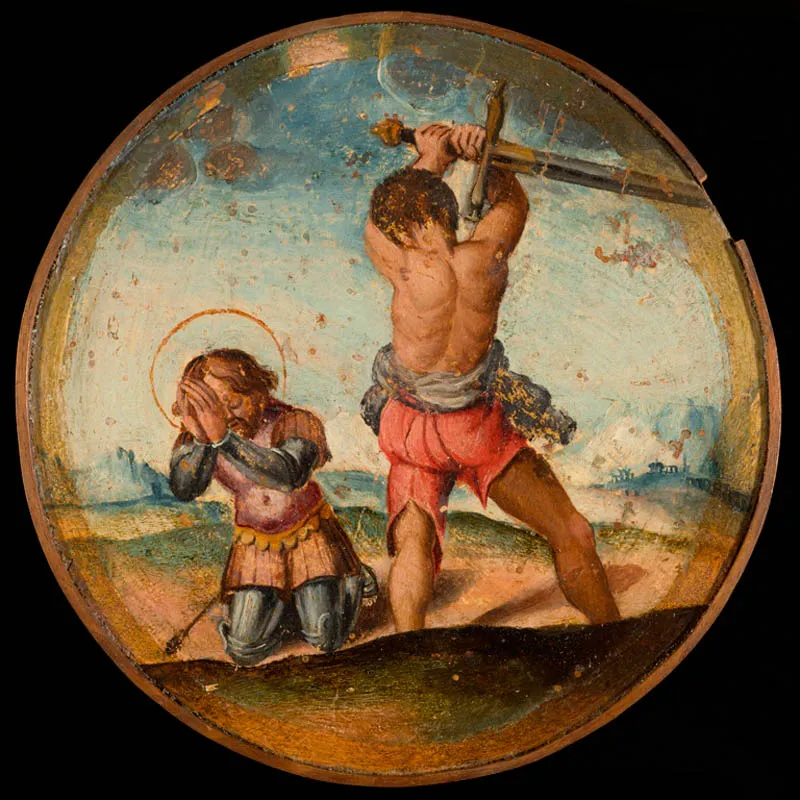
Early Christian Beginnings (5th Century)
Archaeological excavations begun in 2004 revealed that the site of the current Bergamo Cathedral was originally home to an early Christian place of worship dating back to the 5th century. This structure had previously only been theorized due to the lack of documentary evidence. The findings included layered remains beneath the cathedral floor, each corresponding to a different historical period, revealing remnants of Roman urban planning, including a well-preserved cardo (main street), patrician villas, and 1st-century mosaics. These discoveries underscored the early importance and establishment of a Christian community in Bergamo. Christianity in the region is believed to have been introduced by Roman prisoners of Eastern origin, known as Damnati ad Metalla, who were condemned to labor in the iron and stone mines of the Upper Seriana Valley. Upon gaining freedom, they formed Christian communities throughout the area, including Bergamo. These early followers held Saint Vincent of Saragossa in high reverence, dedicating the first church to him. This structure, of Roman architectural style, was significant in size and influenced the surrounding urban layout.
The Ancient Cathedral of San Vincenzo
The oldest known reference to the Church of San Vincenzo appears in a will dated May 774, left by Taido, son of Teuderolfo. It mentions a legacy to the ecclesia Beatissime semper virginis et Dei genitrice Marie et Sancti Vincenti ecclesie Bergomensis, now preserved in the Biblioteca Civica Angelo Mai. A later document from 840, the Privilege of Lothair I, granted Bishop Aganone the authority to investigate properties of both the Churches of Saints Alexander and Vincent to counter illegal claims.
Although Saint Vincent was the original patron saint of the church, his relics were never housed there. A document recounts how Bishop Ambrogio I (971–973) traveled to Cortona to retrieve Saint Vincent’s relics, only to find that Bishop Deodato of Metz had arrived earlier and claimed them. To this day, it is believed the relics may be held in Lisbon Cathedral. During the church’s early years, the surrounding area was referred to as Platea Sancti Vincentii. Artistic and cultural remnants from the Lombard era, including tombs and 13th-century frescoes by the Master of the Rocca di Angera, were uncovered during the recent excavations.
Destruction of the Church of Saint Alexander (1561)
In 1561, during the construction of the Venetian walls, the Church of Sant’Alessandro in Colonna—believed to be located on the site of Saint Alexander’s martyrdom—was demolished for military reasons. As a result, San Vincenzo became the sole cathedral in Bergamo. The relics of Saint Alexander were transferred to San Vincenzo, symbolically uniting the devotions of the city’s two original cathedrals.
Reorganization and Unification (17th Century)
Bishop Giovanni Emo took steps to unify the canons of the two former cathedrals. On 18 August 1697, Bishop Gregorio Barbarigo secured a papal bull from Pope Innocent XI titled Exponi nobis, which officially established a single cathedral chapter and transferred the dedication of the cathedral from Saint Vincent to Saint Alexander. This process culminated in 1704, when the relics of Saint Alexander were enshrined in a new silver urn beneath the main altar. A chapel was also dedicated to Saint Vincent within the new layout, with an altarpiece painted by Carlo Ceresa. However, since Saint Vincent’s original relics were never recovered, a later donation of relics from a Roman martyr named Vincent was not accepted for popular devotion by the citizens.
The New Cathedral (15th–17th Centuries)
In the mid-15th century, Bishop Giovanni Barozzi initiated plans to construct a larger cathedral. The design was entrusted to the renowned Florentine architect Filarete. The new church, still dedicated to both Saint Vincent and Saint Alexander, followed a Latin cross layout with a single nave and three small semicircular chapels on each side, crowned by an octagonal dome. Construction began on 3 May 1459, with the first completed chapel—dedicated to Saint Catherine and Saint Jerome—completed in 1467. Progress halted after Filarete’s death and Barozzi’s appointment as Patriarch of Venice. In 1516, Marcantonio Michiel observed that San Vincenzo lay neglected and unfinished. After several decades of inactivity, work resumed in 1611 under the direction of architect Vincenzo Scamozzi. Significant progress occurred by 1689 when architect Carlo Fontana undertook a major renovation. He elevated the dome, extended the apse, and completed the works in 1693.
19th Century Restoration and the Neo-Classical Facade
The 19th century saw further enhancements to the cathedral, particularly affecting the bell tower, dome, Crucifix Chapel, and interior design. The crowning achievement of this period was the completion of the Neo-classical west façade, inaugurated on 26 August 1889, coinciding with the feast day of Saint Alexander.
Modern Discoveries and the Cathedral Museum
From 2004 onwards, restoration works led to the discovery of the ancient remains beneath the cathedral, confirming many historical suppositions about its early Christian origin. These findings provided an unprecedented understanding of the cathedral’s architectural and urban evolution. On 26 August 2008, Bishop Roberto Amadei inaugurated the newly renovated altar. In 2012, the Cathedral Museum opened beneath the cathedral, offering public access to the historical layers and artifacts uncovered during the excavations. The museum allows visitors to experience the transformation of the cathedral from its early Christian foundations to its modern form.
Architecture of Cathedral Basilica of St. Alexander, Bergamo, Italy
Architect: Filarete
Architectural Style: Italian Baroque architecture, Italian Neoclassical architecture.
External Architecture
The Facade
The grand nineteenth-century facade of the Cathedral of Sant’Alessandro, constructed from elegant white Botticino marble, stands prominently facing the Piazza del Duomo, directly opposite the rear of the historic Palazzo della Ragione. Designed by architect Angelo Bonicelli, work on the façade began in 1866 and was completed in 1889, although some of the decorative details outlined in Bonicelli’s 1878–1879 plans were never executed. Access to the façade is granted by a staircase made from pink granite sourced from Baveno, leading to a lower section that features a three-arched portico. Each arch, formed by a rounded archway supported by sturdy pillars, frames the entrance. The lateral bays of the portico are crowned with small, dome-shaped structures that are frescoed internally and topped externally with bronze statues. The central arch contains two medallions depicting Saints Peter and Paul, sculpted by Luigi Pagani, while a larger central statue of Saint Alexander, crafted by Paolo Sozzi, dominates the upper portion. Flanking this central figure are allegorical statues of the theological virtues Faith and Hope, also by Pagani. Above, the upper façade culminates in a gabled structure, featuring a large rectangular window framed by two elegant Corinthian columns and topped with a classic triangular tympanum, adding a harmonious and majestic finish to the composition.
The Dome
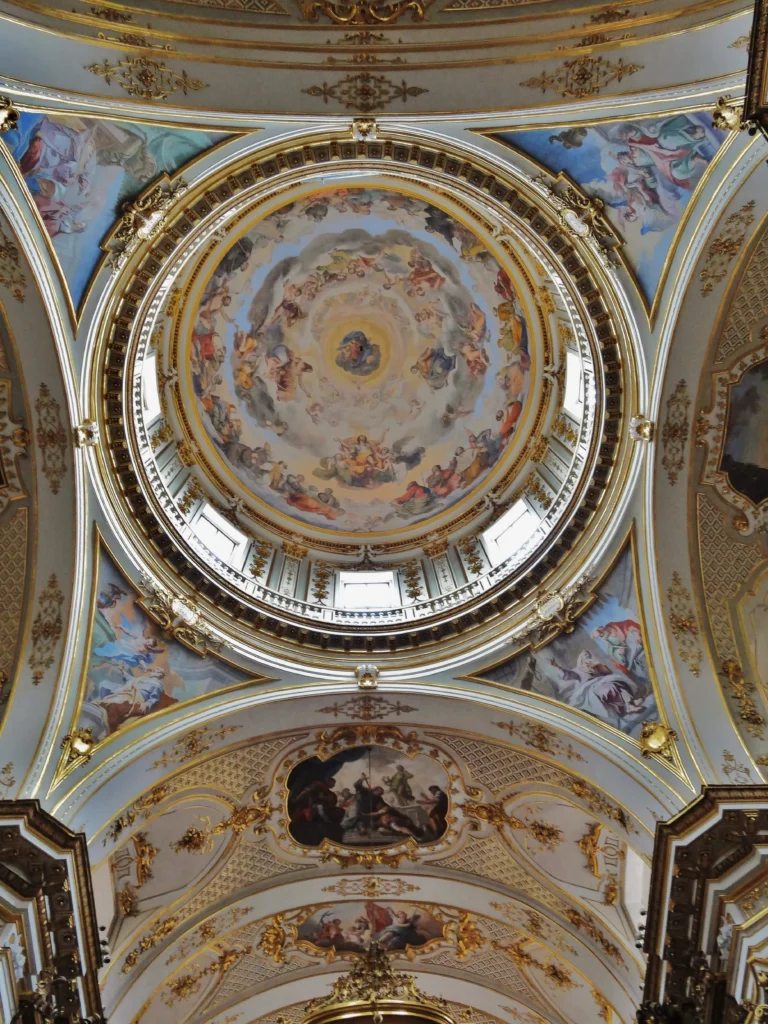
The cathedral’s central dome rises above the crossing of the church. Though completed in 1829, the structure required significant restoration as early as 1853. The dome features a high drum with quadrangular windows and is covered in copper. Atop the dome stands a statue of Saint Alexander the Standard-Bearer, sculpted by Carlo Broggi in 1851. This statue was gilded in 1984, adding to its striking appearance.
South-West Side and Access to Archaeology
The south-west side of the building displays the various construction phases of the cathedral through visible layers of squared sandstone blocks. The upper sections remain unfinished from the 18th century, retaining a rugged, raw appearance. Beneath the portico of the Palazzo della Ragione, a passage leads to the archaeological area, offering insights into the cathedral’s layered history, dating back to the early Christian period.
The Bell Tower
Adjacent to the left of the apse, the bell tower stands tall. Originally built in 1690, it was raised in 1850. Each of its four sides contains a large, round-arched single-lancet window. The bell tower houses a concert of six bells tuned in E-flat major, enhancing the liturgical and ceremonial atmosphere of the cathedral.
Archaeological Area
Access and Discovery
The entrance to the archaeological area is located beneath the portico of the Palazzo della Ragione, leading visitors beneath the basilica itself. Here, one can explore the foundational remnants and structural vestiges of the earlier churches that once occupied the site.
Remains of the Early Christian Basilica
Upon entering the archaeological area, visitors are immediately greeted by the bases of two massive columns that originally supported the central nave of the previous cathedral. Fragments of a 5th-century mosaic floor are also visible, providing a glimpse into the grandeur of the ancient structure. The early Christian church measured approximately 45 meters in length and 24 meters in width, making it the largest known religious building in Bergamo at the time. The floor mosaics, some of which are believed to have been part of earlier Roman residential buildings, display varied orientations, reflecting the continuous redevelopment of the site over different historical periods. Evidence also suggests that the area was already inhabited as early as the 10th century BC, serving both commercial and civil functions, indicating the long-standing significance of this location.
Cemetery and Sarcophagi
The cathedral site also functioned as a cemetery. Excavations uncovered two sarcophagi and additional tombs in the area once designated as the presbytery. One sarcophagus held two richly adorned coffins, accompanied by a staff decorated with polychrome bands.
Iconostasis and Frescoes
The rear wall of the archaeological area features a medieval pluteus, a stone barrier crafted from Zandobbio stone, which was once part of an iconostasis. Above its arches, a series of frescoes from various periods adorn the space, reflecting different artistic styles and religious themes. Notable among these are depictions of Saint John, a “Sant’Anna Metterza” showing two praying donors with Saint Peter, and, on the right pillar, Saint Catherine, Saint Bartholomew, and a crucifix. These artworks suggest the existence of a now-lost upper register, offering insight into the cathedral’s evolving iconographic program. The frescoes span multiple centuries, showcasing a rich diversity in both devotional imagery and artistic expression.
Later Artistic Contributions
Among the later works is a depiction of Christ crucified among mourners, attributed to the Master of the Tree of Life, dating to the 14th century. In the early 1900s, architect Elia Fornoni initiated the creation of a crypt beneath the cathedral for the burial of bishops. During this project, Fornoni rediscovered portions of the ancient church, though safety concerns limited his ability to proceed. Full exploration and documentation only resumed in 2004, when new structural renovations necessitated deeper investigations.
Interior of the Cathedral of Sant'Alessandro
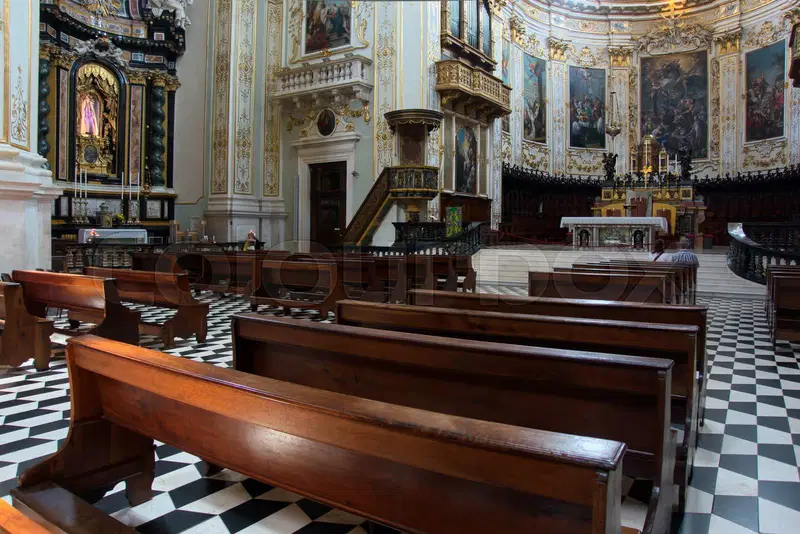
General Layout
The interior of the Cathedral of Sant’Alessandro follows a Latin cross plan, consisting of a single nave that opens into side chapels on both sides. The nave is covered with a barrel vault, which is adorned with lunettes. The design of the cathedral emphasizes verticality and grandeur, creating a sweeping view towards the altar.
Right Side Chapels
The right side of the nave in the Cathedral of Sant’Alessandro is lined with three chapels, each richly adorned with significant religious artwork and dedicated to revered saints of the Catholic tradition.
The first chapel, dedicated to Saint Benedict of Norcia, features an important altarpiece painted by Andrea Previtali in 1524. This masterpiece presents Saint Benedict flanked by Saint Jerome and Saint Louis of Toulouse, capturing a serene and contemplative moment in vivid Renaissance style. The second chapel honors Saint Charles Borromeo. Initially dedicated to Saint George, it was rededicated in 1610 after Borromeo’s canonization. At its center is a striking Crucifixion scene by Giovan Battista Cavagna, portraying the Madonna, Saint John, Saint Charles Borromeo, and Saint Ambrose at the foot of the cross. Complementing the canvas are elegant marble statues sculpted by Giovanni Antonio Sanz, adding depth and devotion to the space.
The third chapel is devoted to the Holy Trinity and also commemorates Saint Gregorio Barbarigo. Tracing its roots to the early iterations of the cathedral, the chapel was redesigned by Nicola Salvi and constructed in 1750 by Giovanni Moroni. The altar features a canvas by Nicola La Piccola that illustrates the Trinity, while Gelpino Caligari’s statues from 1783 depict Saint James and various female saints. Adding historical resonance, the chapel also enshrines relics from San Cassiano and displays a detailed bronze relief altar frontal by Antonio Arrighi, bridging sacred art and deep-rooted spiritual tradition.
Right Transept and Left Side Chapels
In the right transept of the Cathedral of Sant’Alessandro stands the imposing Altar of Saints Fermo, Rustico, and Procolo, an architectural centerpiece designed by Filippo Juvara. This grand altar dominates the space, honoring three of Bergamo’s early Christian martyrs and contributing a powerful spiritual presence to the cathedral’s overall layout. Along the left side of the nave, three chapels mirror those on the right, each with its own unique historical and artistic significance. The first chapel, completed in 1467, is dedicated to Saint Catherine of Alexandria and Saint Jerome. It features a compelling altarpiece by Giovan Battista Moroni from 1576, depicting the Madonna and Child in Glory with Saint Catherine and Saint Jerome. This painting marked Moroni’s artistic return to Bergamo following a decade-long exile and is a prime example of his mature style.
The second chapel, dedicated to the Crucifix, holds a revered 16th-century crucifix originally from Santa Maria di Rosate. Considered miraculous by the faithful, the crucifix was relocated to this chapel in 1810, transforming the space into a site of profound devotion. The third chapel is dedicated to Saints Peter and Paul, a dedication established in 1793. Its striking altarpiece illustrates the apostles entrusting the evangelization of Bergamo to Saint Barnabas, under the benevolent gaze of Mary as Mother of the Church. The chapel is further adorned with marble statues of Saint John the Evangelist and Jude Thaddeus by Giovanni Sanz, and it houses the Madonna dei Canonici, a Byzantine-style painting originally from the ancient church of Santa Maria del Chiostro. This blend of apostolic themes and artistic heritage deepens the chapel’s spiritual resonance.
Left Transept
Altar of the Madonna della Pieta
The left transept features the Altar of the Madonna della Pietà, designed by Canon Marco Alessandri and created by Andrea Fantoni. The cathedral also preserves other artworks in this area, including a Madonna of the Doves attributed to Giovanni Cariani, and paintings by Giambettino Cignaroli and Sebastiano Ricci.
Dome
The Dome’s Construction and Design
The design for the dome was first presented by Carlo Fontana in 1688, with plans for a grand structure that would surpass the height and aesthetic value of the nearby Basilica of Santa Maria Maggiore. However, the cathedral chapter requested a reduced size due to cost concerns. After multiple redesigns, Giuseppe Cusi was entrusted with the project in 1833, but his design suffered from structural issues due to the thinness of the dome’s drum. After several failed attempts, the dome was finally completed between 1853 and 1855 under the guidance of architect Giuseppe Berlendis. The dome is hemispherical, with a copper statue of Saint Alexander atop it. The interior of the dome was frescoed by Francesco Coghetti, featuring the Triumph of Saint Alexander, which complements the cathedral’s overall artistic style.
Counter-Facade
The counter-facade is decorated with paintings by Giovanni Battista Gariboldi from Monza, depicting scenes from the life of Saint Alexander. These include the Beheading of Saint Alexander and the Miracle of the Resurrection of a Dead Man, completed in 1766.
Presbytery and Apse
Presbytery and Altar
The presbytery is accessed via a staircase of seven large white marble steps, leading up to a black marble balustrade. In the center stands the modern community altar, created after the Second Vatican Council. The altar features a 17th-century silver antependium and houses the silver urn containing the relics of Saint Alexander, crafted by Pietro Roberti and donated by the city council in 1702.The high altar, designed by Cesare Targoni in 1588, is a semi-octagonal temple adorned with polychrome marble and gilded figures. It is divided into three orders: the first features the four Evangelists, the second displays Saint Peter and Saint Paul, while the top presents the Risen Christ. In the center of the altar is a painting by Enea Salmeggia, depicting the Redeemer, while the back of the altar features his Last Supper. The altar is supported by six small angels, sculpted by Antonio Fontana in 1715, when the simplicity of the altar was deemed too understated for the grandeur of the basilica.
Apse Paintings
The apse of the Cathedral of Sant’Alessandro is richly adorned with a remarkable ensemble of seven large paintings positioned behind the high altar, each illustrating scenes of martyrdom and sanctity that reflect the deep spiritual legacy of Bergamo’s patron saints. Central among them is the Martyrdom of Saint Alexander, a dramatic and emotive work completed in 1694 by Nicola Malinconico. Flanking this central painting are six additional canvases: Francesco Polazzo’s Episcopal Consecration of Saint Narno, Francesco Monti’s Preaching of Saint Viator, and the powerful Martyrdom of Saint John Bishop by Giambattista Tiepolo, painted between 1743 and 1745. Completing the series are the Martyrdom of Saint Proiettizio by Gian Bettino Cignaroli, the Martyrdom of Saint Esteria by Giovanni Battista Pittoni, and the Martyrdom of Saint James by Silvestro Manaigo.
Adding to the grandeur, the apse basin is decorated with an image of Saint Alexander, while the altarpiece of Saint Joseph, Saint Anthony, and Saint Adelaide—which includes a depiction of the façade of the Church of San Michele all’Arco—was painted by Carlo Innocenzo Carloni. These artworks not only enhance the aesthetic beauty of the cathedral but also serve as a visual catechism, narrating the faith and sacrifice of Bergamo’s most venerated saints.
Wooden Choir in the Apse
The wooden choir in the apse of the Cathedral of Sant’Alessandro is a striking example of late 17th-century ecclesiastical craftsmanship. Carved by Gian Carlo Sanz between 1693 and 1698, the choir features 44 intricately detailed stalls for the canons of the Chapter. Measuring 30 meters in length and 3.5 meters in height, the structure is adorned with carved caryatids that illustrate various biblical themes. Notably, the twenty-second caryatid includes a self-portrait of the sculptor, signed with the Latin inscription “Joannes Carolus Sanz Sculpsit 1695.” Above the altar in the left transept, a marble bas-relief of the Life of Christ—also attributed to Sanz—continues this decorative narrative. At the center of the choir stands the bishop’s chair, a 1705 work by Andrea Fantoni. It is distinguished by the coat of arms of Bishop Luigi Ruzzini and features two carved wooden medallions depicting Solomon at the Temple of Jerusalem and the anointing of King David by Samuel. The chair is completed with a finely crafted kneeler, combining both liturgical purpose and artistic elegance.
Crypt of the Bishops
Beneath the choir lies the baroque crypt, restored between 1979 and 1980 under the guidance of architect Bruno Cassinelli at the initiative of Bishop Giulio Oggioni. This solemn space serves as the final resting place for twelve bishops, with their tombs arranged in a circular layout along the sides of the chamber. At the center stands a cylindrical altar, above which rises a striking bronze sculpture of the Resurrected Christ, created by Piero Brolis. This crypt, both reverent and austere, embodies a serene atmosphere ideal for prayer and remembrance.
Sacristy
The sacristy of the cathedral preserves several artistic treasures. Among them are works by Giovan Battista Moroni, one of Bergamo’s most celebrated painters. The space also contains a finely carved and gilded wooden compartment—a fragment of a 15th-century polyptych—which once adorned a previous altar.
Pipe Organs of the Cathedral of Sant’Alessandro
The Cathedral of Sant’Alessandro boasts three distinguished pipe organs that enhance its rich musical and liturgical tradition. The Bossi Organ, built in 1842 by Felice Bossi and restored in 1995 by Mascioni, is situated on the choir loft along the left wall of the apse. This historically significant instrument features mechanical transmission, a single 58-note manual keyboard, and a 20-pedal music stand pedalboard. While the first 18 pedals produce real notes, the final two operate special effects known as Terza Mano and Rollante. The organ is appreciated for its authentic 19th-century tonal qualities and is primarily used in traditional worship settings.
The cathedral’s principal instrument, the Corna Organ, was crafted between 2009 and 2010 by Pietro Corna. It incorporates the sound material and console of the earlier Balbiani-Vegezzi Bossi organ from 1943, which had undergone expansion in 1995. With electronic transmission, the organ includes two consoles: the main one, installed in the apse in 2013, features four 61-note manuals and a 32-note concave-radial pedalboard, with stops and couplers managed via side-mounted knobs. The secondary console, located in the left arm of the transept, is the adapted Balbiani version, with three manuals and similar pedalboard, operated using balance plates. The majority of the pipework is positioned in the right-hand gallery of the presbytery, while the expressive division is housed in the left transept gallery. In addition, the Positive Organ, located in the Chapel of the Addolorata, was built in 2009 by Silvio Zambetti. This small, mechanical-action instrument features a 54-note manual and no pedalboard, making it well-suited for intimate choral accompaniment and smaller liturgical celebrations. Together, these three organs offer a dynamic range of soundscapes, from solemn ceremonial music to more subtle, devotional tones.
Baptistery of Bergamo: History and Architecture
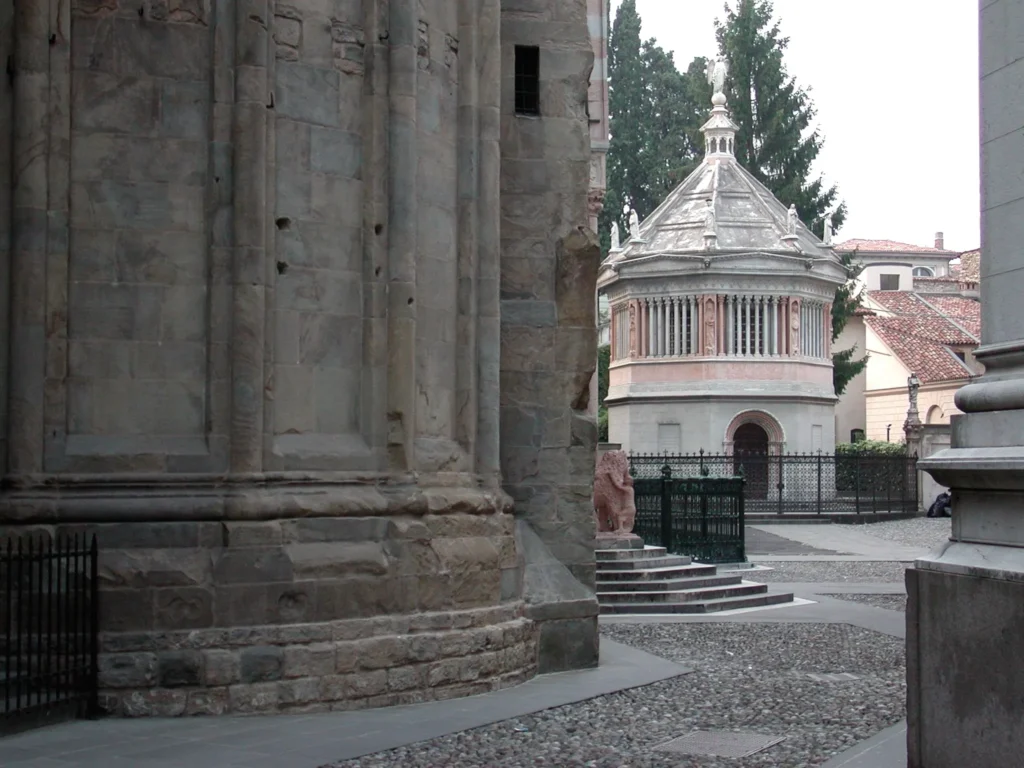
The Baptistery of Bergamo, located opposite the façade of the Cathedral of Sant’Alessandro, is an architectural and historical marvel. Originally built in 1340 by Giovanni da Campione for the Basilica of Santa Maria Maggiore, it was dismantled in 1660 during major building works but was carefully preserved and later reassembled in 1856 in the Canons’ courtyard. By 1900, it was relocated to its current site and reconstructed in a neo-Gothic style. The baptistery features an octagonal structure with a splayed round-arched portal and a false loggia, adorned with slender columns and eight statues of red Verona marble. These statues represent the three theological virtues—Faith, Hope, and Charity—alongside the four cardinal virtues—Justice, Prudence, Fortitude, and Temperance—as well as the virtue of Patience. The roof is topped with a dome and a small lantern surmounted by a statue of an archangel. Inside, the baptistery houses a central baptismal font, created by Giovanni da Campione in 1340, with intricate Gothic decorations. Behind the font stands an altar with a marble statue of St. John the Baptist in a trilobate niche. The walls are decorated with bas-reliefs depicting scenes from the Life of Jesus, also by Giovanni da Campione. A colonnade runs around the upper level, with statues of virtues standing above, contributing to the baptistery’s spiritual and architectural significance.
Feast Day
Feast Day : 26th August.
The feast day of the Cathedral Basilica of St. Alexander in Bergamo, Italy, is celebrated on August 26th. This date honors Saint Alexander of Bergamo, the patron saint of the city, who is believed to have been martyred on this day in 303 AD. The Cathedral, dedicated to Saint Alexander, is the central place of worship and significance for the people of Bergamo, where the saint’s legacy and martyrdom are commemorated annually.
Church Mass Timing
Monday to Friday : 7:30 AM, 6:00 PM.
Saturday : 6:00 PM.
Sunday : 7:30 AM, 9:00 AM, 6:00 PM.
Church Opening Time:
Monday to Friday : 7:30 am – 12:30 pm., 3:00 pm – 6:30 pm.
Saturday : 7:00 am – 7:00 pm.
Sunday : 7:00 am – 7:00 pm.
Contact Info
Address :
Cathedral Basilica of St. Alexander
Piazza Duomo, 24129 Bergamo BG, Italy
Phone : +39 035 210223
Accommodations
Connectivities
Airway
Cathedral Basilica of St. Alexander, Bergamo, Italy, to Il Caravaggio Int’l Airport (BGY), distance between 12 min (5.4 km) via Via Autostrada.
Railway
Cathedral Basilica of St. Alexander, Bergamo, Italy, to Piazzale Guglielmo Marconi, distance between 8 min (1.3 km) via Viale Papa Giovanni XXIII.

